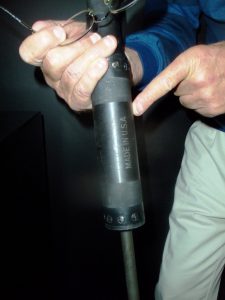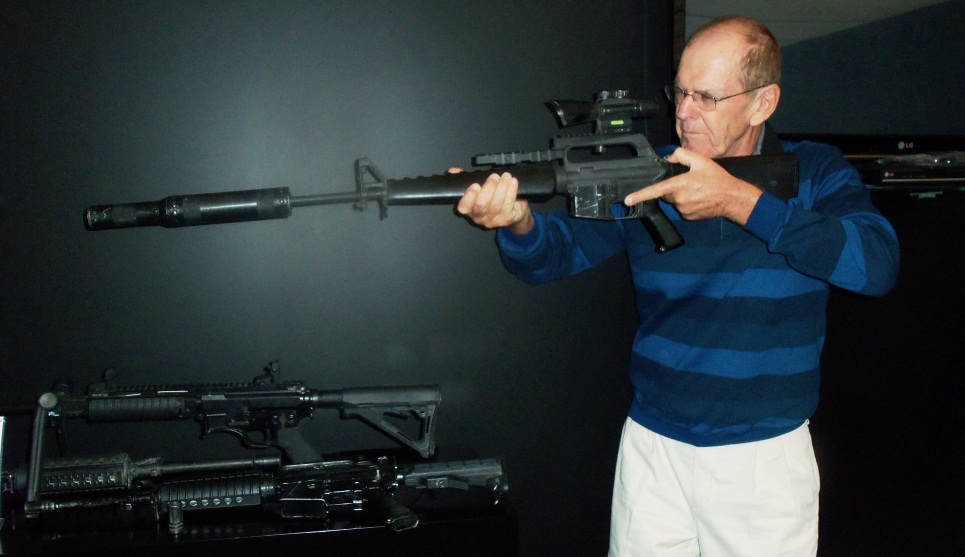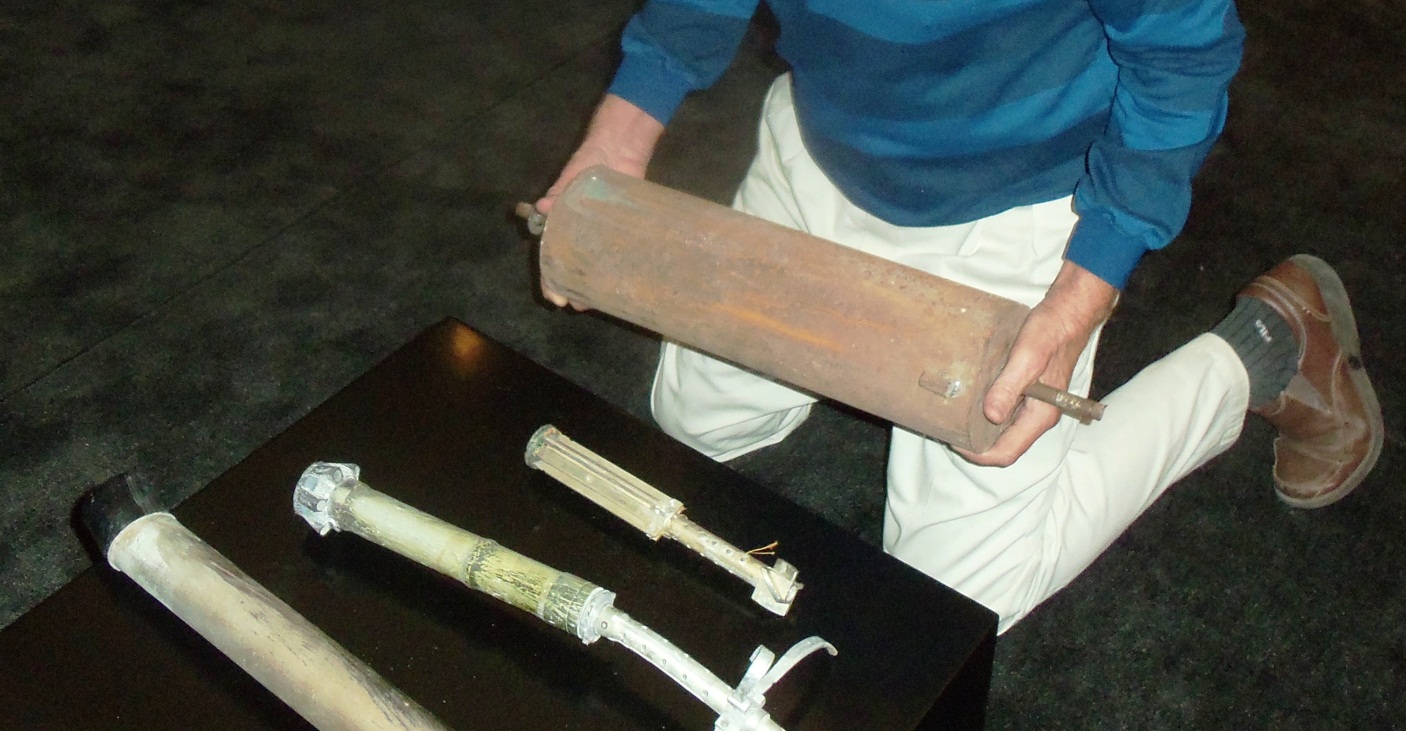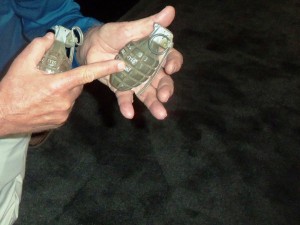This observer also examined and was briefed on M72 LAW and AT-3 anti-tank missiles developed by the United States. But the extent of their use is difficult to verify. Most of the arms shown in the photos accompanying this report are from the main urban centers and near the Turkish, Iraqi, Lebanese, and Jordanian borders.
In tightly built up urban areas such as Homs, Idlib and Aleppo, door to door fighting includes a battle among snipers. According to one Syrian military intelligence source in whose Damascus office this observer discussed the subject, the most frequently confiscated sniper rifles currently being found in the hands of “rebels” include:
- the U.S. Army & USMC M1903-A4 (also: USMC M1903-A1/Unertl), the U.S. Army & USMC M1C & M1D and U.S. Army M21;
- the Israeli M89SR Technical Equipment International 7.62x51mm NATO Semi-automatic, Galil Sniper Rifle and the T.C.I. M89-SR;
- the British .243 Winchester, 7.62x51mm NATO/.308 Winchester,.300 Winchester Magnum, and the 338 Lapua Magnum Bolt action sniper rifles.

American weapons from Iraq, Afghanistan, Turkey and NATO stores are entering Syria with the aid of Qatar and Saudi Arabia and black market arms dealers. Damascus, October 23, 2012. (Photo courtesy of the author).
A few Afghanistan era Russian Dragonov SVD and SV-98 sniper rifles have also been confiscated among an assortment of others.
Foreign jihadists have some access to Soviet-era DShK heavy machine guns or ZU-23-2 anti-aircraft cannons which are used for anti-aircraft and fire support. Both use fairly scarce high-explosive rounds and armor-piercing rounds, which are capable of penetrating the armor of the Syrian military’s BMP infantry fighting vehicles. The ZU-23-2 “Sergey”, also known as ZU-23, is a Soviet-made towed 23mm anti-aircraft cannon. Vehicle mounted Zu-23-2’s are relatively easy to spot by government aircraft, and artillery units are used to attack a target and quickly flee to avoid counter strikes.
On October 25, Russia reiterated its claims that the US assists and coordinates arms deliveries to foreign-sponsored insurgents battling the Syrian government forces. Russia’s chief military officer said that Syrian armed groups have acquired US-made weapons, including Stinger anti-aircraft missiles. This observer saw many weapons from more than a dozen types of IED’s (improvised explosive device) to medium sized artillery pieces but no missiles.
[7 – Improvised Explosive Devices are a key rebel weapon with many arriving from Iraq and camps near Hataya, Turkey, and others DIY (do it yourself) improvisations. Damascus, October 24, 2012. (Photo courtesy of the author).]
According to the Russian Foreign Ministry issued statement of October 25, “Washington is aware of the deliveries of various weapons to illegal armed groups active in Syria. Moreover, judging by the declarations of US officials published in US media, the US coordinates and provides logistical assistance in such deliveries.”
Some analysts in Damascus claim that Syria’s potential military strength has not been as effective as it could be in the current urban fights against rebels. The government appears very strong militarily if one studies the statistics regarding Syria’s large and disciplined army, which continues its support, and also given its sophisticated long range missiles, air defense systems that have deterred an airborne attack from Israel. One reason that progress has at times appeared slow against the “rebels”, according to some local analysts, was a certain initial unpreparedness to confront highly motivated guerrilla militia in downtown densely populated areas. These kinds of battles, it is claimed, require a mobile infantry, armored flexibility and very effective use of light arms. The Assad government’s “adapt, catch up and go on the offensive” paradigm is developing rapidly according to US Senate Armed Service Committee sources who assert that the Syrian army has actually become battle hardened, tougher, stronger and more disciplined over the past several months. But it has taken time and has incurred a significant cost.
Weapons examined by this observer in Syria during October include some of the more than 1,750 new American sniper rifles channeled from Iraq and NATO supply stores to rebel militia.

The most frequently confiscated sniper rifles currently being found in the hands of “rebels” in Syria include the above shown U.S. Army & USMC M1903-A4. (Photo courtesy of the author.)

Improvised Explosive Devices are a key rebel weapon with many arriving from Iraq and camps near Hataya, Turkey, and others DIY (do it yourself) improvisations. Damascus, October 24, 2012. (Photo courtesy of the author.)
How Foreign Weapons are Entering Syria
As widely speculated particularly in the regional media, foreign supplied weapons to “rebels” arrive by air, sea, and mainly by land from Iraq, Turkey, Lebanon, Saudi Arabia, Qatar, Jordan, and occupied Palestine.
Israel is reported by some researchers in Damascus who have been covering the crisis for nearly 20 months to be sending arms to Syria from Kurdistan, having had much experience in Africa, South America, and Eastern Europe via Mossad and Israeli black market arms dealing. What Israel did in Libya in terms of a widespread arms business it is also trying to do in Syria. Israeli arms, according to Syrian and Lebanese sources, are being transported into Syria from along the tri-border area of South Lebanon, near Shebaa Farms, close to Jabla al-Saddaneh, and Gadja. In addition, Israeli smugglers have increasingly over the past five months been seen by locals moving arms inside Syria via the Golan Heights. These violations of Syrian and Lebanese sovereignty raise serious questions about the vigilance of the United Nations Disengagement Observer Force Zone (UNDO) based in the Golan Heights as well as the UN Interim Force in Lebanon (UNIFIL) and the Lebanese Army as well as National Lebanese Resistance units near the ‘blue line’ to stop the illicit Israeli arms transfers.
The recent arrival in southern Turkey and along the northern Syrian border of Blackwater mercenaries is expected to increase the foreign arms flow. Currently using the name Academi (previously known as Xena- Xe Services LLC, Blackwater USA and Blackwater Worldwide) Academi is currently, according to Jane’s Defense Weekly, the largest of the US governments “private security” contractors. Details of its relationship with the US Defense Department and the CIA are classified.








Mr. Lamb belongs to those renegade Jews who are obsessed with self-hate in addition to the maniacal hatred towards all things Jewis and Israeli.Therefore his articles shol not be published at all, as they are pure racism.
Of course,he is hiding his vicious antisemitism behind the word “zionism”‘…
Mr. Lamb is a typical example of a kapo-type collaborating with all the Israel-haters.But he should not believe that Israel will disappear from the map only because he wishes so.We survived all our haters and will survive many more.
Characterizing criticism of Israel and Zionism as “racism” is moral and intellectual cowardice.
why do you think that Israel interst is to achieve regime changed in syria? Asad regime keeps the agreements and silent in the borders between Syria and Israel. To replace it by extreme muslems is not good for the intersts of Israel.